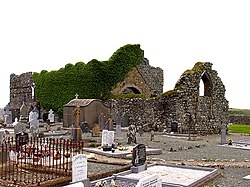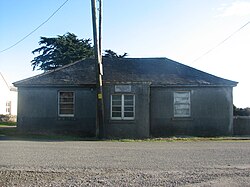Bannow
| Bannow Irish: Banú | |
| County Wexford | |
|---|---|
 Ruined church and graveyard, Bannow | |
| Location | |
| Grid reference: | S834078 |
| Location: | 52°12’59"N, 6°46’49"W |
| Data | |
| Dialling code: | 051 |
| Local Government | |
Bannow is a village on the east of Bannow Bay on the south-west coast of County Wexford. In modern times the main settlement is the village of Carrig-on-Bannow (or Carrig). In Norman times there was a borough called Bannow on Bannow Island at the mouth of the Bay. This town has since disappeared, probably due to the silting up of the natural harbour channels in the 14th century, and the former island is now attached to the rest of the parish.
The name is in Irish is given as Banú[1]
Contents
History
It is believed that the Vikings had a strong early presence in the area, due to the survival of numerous Norse place-names in the locality. The Norman conquest of Ireland began in Bannow Bay in 1169, when three ships commanded by Robert Fitz-Stephen arrived at the behest of Diarmait MacMurrough to support his claim to the Kingdom of Leinster. Another group of Normans under Raymond le Gros landed the following year on the far side of Bannow Bay, on the Hook Peninsula at Baginbun, which was then called Dún Domhnaill. There was a small promontory fort there, easy for the Normans to defend and thereby ensure a safe landing.[2]
At Bannow Island, the ruins can still be seen of the 13th-century Norman Romanesque parish church of St Mary, originally impropriated to the monks of Canterbury.[3] It consists of a nave and chancel. Another famous Norman soldier and officer who landed in the first invasion was Meiler Fitzhenry, whose son adopted his father's name, and thus began the Meyler family of County Wexford, who later were prominent in the Wexford Rebellion of 1798.
Bannow Borough was a borough constituency returning two members to the Parliament of Ireland until the Act of Union 1800 disenfranchised it. It was a pocket borough with the same proprietor and electors as Clonmines Borough, another rotten borough for the deserted town of Clonmines at the northern limit of Bannow Bay. The most prominent local landlords in Bannow from the late 17th century were the Boyse family, who lived at Bannow House. The last member of the Boyse family left the area in 1948.[4]
During the Irish Rebellion of 1798, the fleeing loyalist garrison of the town of Wexford crossed the nearby Scar at Barrystown on their way to Duncannon Fort. In the late 19th century, the area was heavily involved in the Land Wars.[5]
Geography
Bannow is a Roman Catholic parish.[6] The parish church in Carrig-on-Bannow was first built in 1856 and has been altered several times since. It has an adjoining cemetery. Carrig also has a national school, Garda Station,[7] handball alley, post office, a café, four estates, a doctor's office, a farm, a corner shop, two bars, and public houses. Half a mile away is a Church of Ireland church at Balloughton, and at nearby Grantstown is an Augustinian priory. There are beaches on Bannow Island, at Cockle Strand, Blackhall, and Cullenstown.
Sport
- Gaelic Athletics: Bannow-Ballymitty GAA Club,[8] which has pitches located at Grantstown.
- Camogie: Bannow-Ballymitty Camogie Club, founded in 1950
- Ladies football club
- Corach Ramblers soccer club
- Handball is also played at Ballymitty Handball Club
References
- ↑ Banú / Bannow: Placenames Database of Ireland
- ↑ "Culturalheritageireland.ie". October 2023. http://www.culturalheritageireland.ie/index.php/irelands-top-100-heritage-discoveries/81-irelands-top-100-heritage-discoveries/158-the-anglo-norman-invasion-of-ireland-raymond-le-gross-fort-at-baginbun.
- ↑ Grattan Flood, W. H. History of the Diocese of Ferns. Waterford: Downey & Co., 1916, p. 143.
- ↑ "Local Guide ||| Ireland Reaching Out". http://www.irelandxo.com/ireland/wexford/bannow/place-interest/bannow-house.
- ↑ "EVICTIONS (IRELAND)—WEXFORD COUNTY.". Parliamentary Debates (Hansard). 26 August 1886. https://api.parliament.uk/historic-hansard/commons/1886/aug/26/evictions-ireland-wexford-county.
- ↑ Carrig-on-Bannow/Bannow RC Church Template:Webarchive, ferns.ie; accessed 16 January 2015.
- ↑ Garda Station telephone numbers Wexford/Wicklow Division, garda.ie; accessed 16 January 2015.
- ↑ Bannow-Ballymitty GAA Club, Co. Wexford Template:Webarchive.
